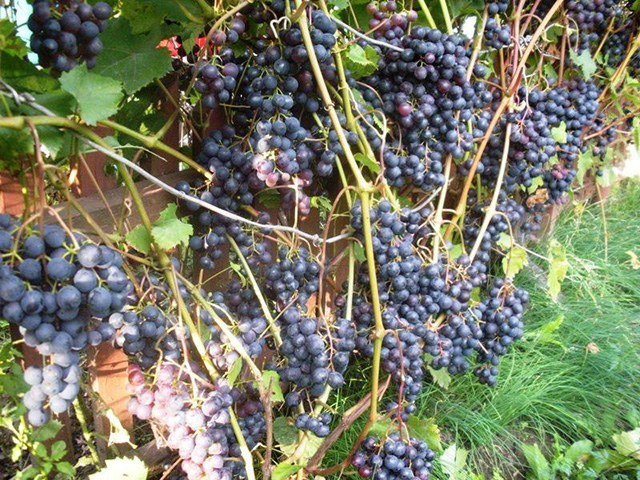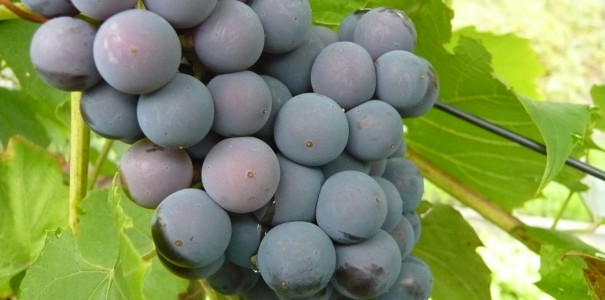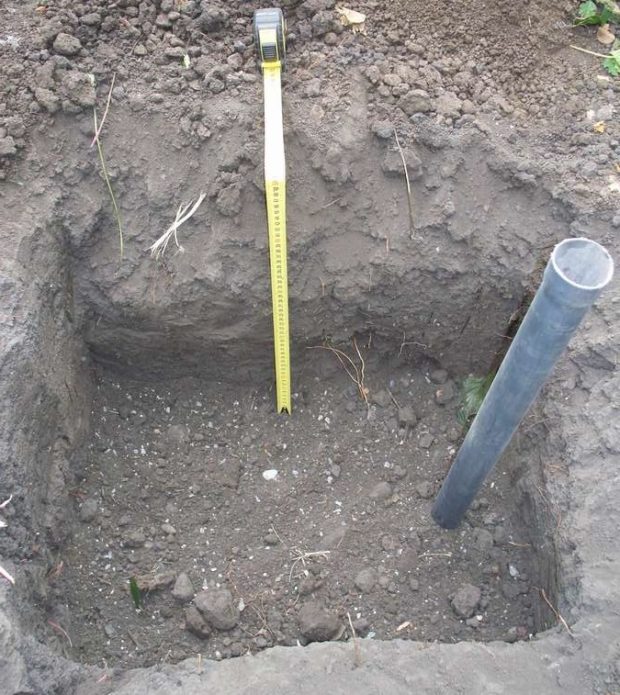Several decades have passed since the cultivation of grapes in central Russia and the Siberian region has ceased to be exotic. The reason for this turn was the emergence of frost-resistant varieties intended for harsh climates. One of them is the Riddle of Sharov - a variety that has been known for almost half a century, but still finds its fans. It is the ideal choice for a northern summer resident taking their first steps in viticulture.
Content
Breeding history, description and characteristics of the grape variety Sharov's Riddle
Altai breeder and enthusiast Rostislav Sharov worked on obtaining frost-resistant grape varieties in the last third of the last millennium. Experts believe that, by and large, it was his labors, carried out in the Altai city of Biysk, that laid the foundations of northern viticulture. In the 1970s-1980s. R.F.Sharov obtained about a dozen varieties characterized by very high frost resistance, and for this he had to pass through his hands more than 200 varieties of grapes, claiming to be the parents of new hybrid forms.
The success of growing grapes in a particular climatic zone depends both on the winter temperatures to which frosts reach in a given area, and on the annual sum of average daily positive temperatures. And if the first position can be fought to some extent by seriously covering the grape bushes for the winter, then nothing can be done with summer temperatures: if it is constantly cold in some area, then most grape varieties will not ripen elementarily. Therefore, the breeding work of RF Sharov was aimed at solving both of these problems.
It turns out that the sum of positive temperatures in Altai is approximately at the same level as in central Russia (Moscow, Ivanovo, Nizhny Novgorod, etc.) and even in such cities of Siberia and the Urals as Omsk or Chelyabinsk. But in winter, extreme frosts occur in Biysk, reaching -40 ° С, and sometimes up to -50 ° С. Therefore, the varieties bred for the Altai region are successfully grown practically throughout Russia.
Sharov's Riddle - one of the best varieties of the Altai amateur breeder - was obtained in 1972 on the basis of the Far Eastern 60 variety by pollinating it with pollen from European grape varieties - Magarach 352 and Tukai. The “father” itself - Far Eastern 60 - came from the super-frost-resistant Amur grapes, for which frosts down to -40 ° C are not afraid without shelter. For Riddle, this indicator turned out to be more modest, of the order of -32 ° C, but this is enough so that the grapes could not be sheltered for the winter in a larger territory of our country; there are very few such varieties. Due to its high frost resistance, the variety is often used as a rootstock for grafting more capricious, but high-quality varieties in terms of berries.
Tukai grapes ripen quite well in remote corners of our country - in the northern regions, in the northwest, in Bashkiria and in Transbaikalia:https://flowers.bigbadmole.com/en/yagody/vinograd/vinograd-tukay-opisanie-sorta-foto-otzyivyi.html
And since with a short pruning (2-3 eyes) you can leave a large number of shoots, the overall harvest from the bush turns out to be very good: from an adult bush Sharov's Riddle you can collect up to 40-45 kg of berries. True, high yields are fraught with non-ripening of the vine, therefore they are usually rationed, and in reality they are about twice as modest.
This grape belongs to the varieties of the very early ripening period: it takes about 3.5 months from the swelling of the buds to harvest. Since the bush is small after the autumn pruning, in early spring it is possible to build a temporary shelter from the film over it, than to achieve an earlier awakening and shorten the growing season.
The bush at the Riddle of Sharov in the summer is quite large, since the shoots grow very quickly: in a short time they reach three meters in length and more. They ripen early, but not always to full length. Shoots are flexible because they are thin. The eyes are large, well visible, the distances between adjacent eyes are small. The leaves are medium-sized, five-lobed, smooth, of the usual green color, bright.
The flowers of this grape are bisexual, so replanting bushes of another variety for pollination is not required. Most shoots form inflorescences and clusters, but it is not recommended to leave more than 2-3 specimens per shoot. Clusters are medium in size, weighing about 500 g, highly branched and winged. The packing of berries in a bunch is medium, loose.
The berries are round, and if earlier their size was considered average, now, when many large-fruited varieties have been bred, it is more correct to say that they are below average: the berry mass is from 2 to 3 g. Their color is dark blue, sometimes almost black, with a small wax bloom. No peeling: all berries are approximately the same size. The skin is thin, but dense, although it does not interfere with the use of berries. The seeds are small, 2 or 3 per berry.

If the harvest is not rationed, a lot of berries will be obtained, but this can harm the state of the bush.
The pulp is very juicy, sweet, and has a pleasant taste: when fully ripe, the sugar content reaches 22%. The taste contains fruit and berry shades, reminiscent, depending on the degree of ripeness, either strawberries, then pears, or raspberries. It is believed that among the varieties of one class of frost resistance, Sharov's Riddles berries have almost the best taste. Untimely harvesting is not terrible for the variety: the berries stay on the bushes for a long time, almost without crumbling and without deteriorating in taste. The harvested crop can be stored in a cool place for up to three months.
Iron vitriol in the fight against diseases and pests in the vineyard:https://flowers.bigbadmole.com/en/yagody/vinograd/obrabotka-vinograda-zheleznyim-kuporosom.html
Features of planting and growing grapes Sharov's Riddle
Planting grapes of the Zagadka Sharova variety is generally simpler than planting most other varieties. Caring for an adult bush is also easy, well and a lot of work is needed only at the beginning.
Landing
If it is usually said that grapes should be planted in fertile soil, this does not apply to the variety in question. Of course, the Riddle will respond with gratitude to any improvement of the soil, but it grows successfully even on stones and in sand. The fact is that the variety forms incredibly long roots (up to 10 meters), capable of finding water and food far from the bush and deep underground.Therefore, in fact, the bush must be provided with food only for the first few years, until the seedling takes root and develops the root system. Nevertheless, the landing pit still needs to be equipped according to all the rules.
If possible, a large hole should be dug, but a size of 60 x 60 x 60 cm will be sufficient. The main thing is that a drainage layer of crushed stone or broken brick should be laid at the bottom in the case of heavy soil, and a vertical pipe for irrigation should be laid to the future roots. early years. Fertilizers are placed on the bottom of the pit, any other than fresh manure, mixing them well with the ground. The top layer where the seedling will be placed should be clean, fertile soil without fertilizers. If planting is planned for the spring (and this is the best option), the pit must be prepared in the fall.
Sharov's riddle will grow everywhere, but ideally, a sunny area protected from winds should be chosen, preferably on a hill where water does not stagnate from rains and melting snow. Best of all - on the south side of any building.
The planting process does not present any difficulties. Like any other grape, this variety can be planted with a one- or two-year-old sapling and even a cuttings: cuttings survival rate is very high. But it is better, of course, to grow a seedling from a cutting at home and already place it in a planting pit. They are planted deeply, leaving one or two buds above the ground, watered well and be sure to mulch with any loose material.
Care
In the first years of life, the bush needs careful care, consisting in timely watering (through a buried pipe, right into the root zone), loosening and pruning. In the first year, all shoots, except for the central one, are cut out, achieving full ripening. And already in the second year there is an opportunity to taste the first berries.
It is most convenient to carry out the main pruning in the fall, after leaf fall, when all the vines are in full view. Subsequently, pruning is needed every year, and very careful: gradually the load on the bush is increased, but each shoot is cut short. In the first three years, only two eyes are left on each shoot, in the subsequent up to four. The total number of shoots in an adult bush can be brought to thirty.
We also have to ration the yield: no more than two bunches should be left on each shoot. To facilitate autumn pruning and improve the ripening of the vine, it is necessary to walk through the bush throughout the summer and break out the obviously extra green shoots and stepsons that appear: the sooner they are removed, the better.
Watering this grape variety in adulthood is required only in dry years. As a rule, it is grown in regions that do not suffer from a lack of rainfall, so rainwater is generally enough for the development of the bush. But if you have to water, you should not do this with the beginning of the ripening of the berries, that is, 3-4 weeks before the expected date of harvest. And you don't even need to feed Sharov's Riddle often. Once every few years, you can bury 1-2 buckets of humus under the bush, but basically you can do with scattering wood ash around the bush: you can use it a lot, any grapes really need ash.
You should not indulge in optimism and assume that everything will be easy with this variety. There is one very serious point: Sharov's riddle is very susceptible to fungal diseases, especially often she suffers from mildew. In the prevention of this disease, the timely clarification of the bush, which allows it to be well ventilated, is very helpful. In addition, it is necessary to ensure that the vines do not touch the ground, in time to tie them to the trellises. Preventive spraying is required in the spring. Before the kidneys swell, it is better to use a solution of ferrous sulfate, and along the green cone, treatment with Bordeaux liquid is possible, strictly according to the instructions.If trouble has overtaken, you cannot do without special preparations, for example, Ridomil Gold, and during the filling and ripening of berries, you cannot use more toxic chemicals than potassium permanganate or colloidal sulfur.
Advantages and disadvantages of the variety in comparison with similar
From the above description of the Zagadka Sharova variety, it follows that it is an excellent choice for a novice winegrower living in a harsh climate: it has a very high frost resistance and does not require high qualifications for growing. Of course, this is not the ideal variety. However, in its segment, it really is one of the best. So, if we compare the Riddle of Sharov with modern super-early varieties (for example, Timur or Livia), then its undoubted advantage is its high frost resistance. And if a comparison is made with a group of frost-resistant varieties (Isabella or a group of Amur grapes), here the Riddle has a much higher quality of berries.
The undoubted advantages of the variety are:
- the highest frost resistance;
- the ability to grow and bear fruit on any soil;
- thin vines, making it easy to wrap them up for the winter;
- short growing season;
- ultra-early maturity;
- unpretentiousness to growing conditions;
- high and stable yield;
- excellent berry taste and versatility of their use;
- buncation of flowers;
- crop safety on the bushes and good keeping quality.
A serious drawback of the variety is its weak resistance to fungal diseases, and especially to mildew. This requires constant monitoring of the condition of the bush, mandatory prophylactic spraying, the availability of drugs at hand, which are "first aid".
Preparations for protecting grapes from diseases and pests:https://flowers.bigbadmole.com/en/yagody/vinograd/obrabotka-vinograda-osenyu.html
Video: a specialist about grapes Sharov's Riddle
Reviews
I have Sharov's Riddle since 2007. In general, the impression is good, it ripens earlier than anyone else. Of the minuses, it easily picks up mildew and a very loose bunch. The rest seems to be fine, although of course there are many more delicious varieties. The berry hangs on the bush for a long time without losing its taste. Sugar in the berries begins to appear already during the dyeing period, so it is not necessary to wait for full maturity, you can slowly start eating. On July 6, I noticed that some berries began to color ...
In 2009, my wife, together with the seedlings of flowers, bought a seedling from the nursery of Zagadki Sharova. He was infected with mildew. I fought with her for 4 years with zero result. The last year of 2013 was rainy and the infection spread to Alyoshenkin. Than just he did not treat Bordeaux, Profit. In the last year, I worked every week and immediately after the rain with Ridomil, but everything is useless. In the fall, he gave up and removed both bushes from the site. And the grapes were sweet.
Sharov's riddle - just ahead of the rest of the planet - hibernates with me pressed to the ground almost "from birth", wakes up among the first, now it is all strewn with blossoming buds (which cannot be said about other varieties in this wintering), about the taste and ripening times already said-retold - AMAZING variety. Of course, the berries are too small and the clusters are loose, but for myself ... just a clever girl.
I would like to share my opinion on Sharov's Riddle.I think for a novice grape lover this is the most problem-free variety. I poked the stalk into the ground in the spring and forgot about it until next spring (at least that's how I started). And while it is growing, you can read literature. It can endure any formation (I did not have any for the first 3 years - I did not know then that it needed to be formed), fruitful, early - the first berries at the end of July. And in general, he forgives a lot to a novice winegrower.
Video: grape harvest Sharov's Riddle in Kuzbass
The Zagadka Sharova variety is one of the most reliable grape varieties for growing in harsh climatic conditions. Being very frost-resistant, it is also of interest from the point of view of the quality of berries used both fresh and in various preparations. Since caring for these grapes is easy, it can be recommended for novice summer residents: at least their first experience of viticulture will not disappoint them.





